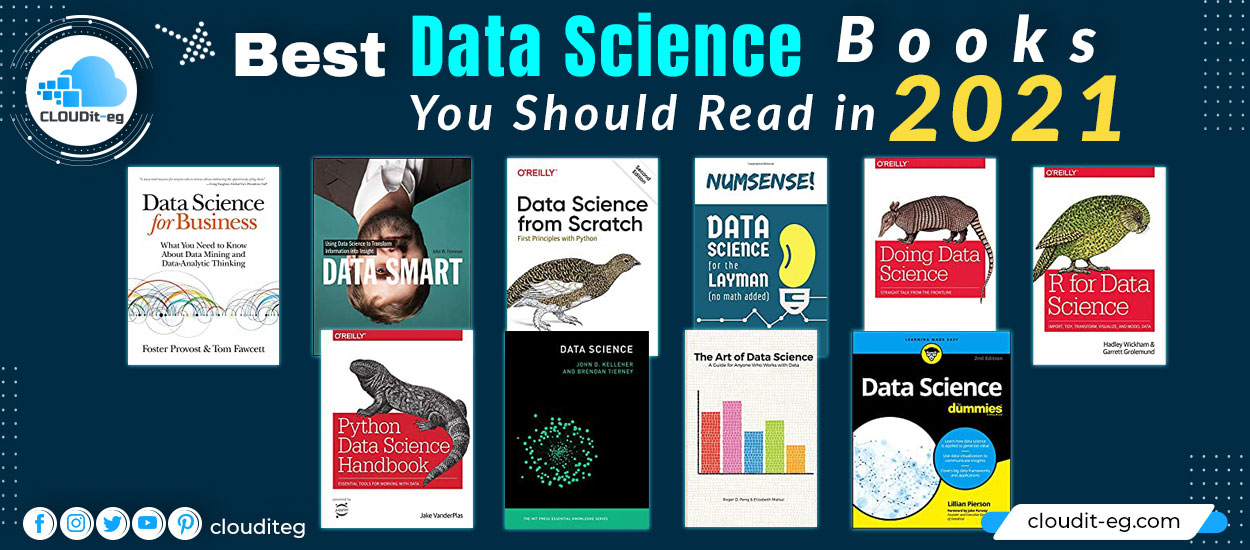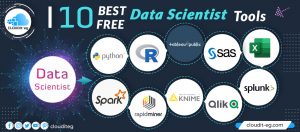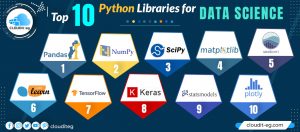Data science involves mathematics, statistics, and computer science and integrates techniques such as Machine Learning, topological analysis, data mining, and visualization. In this article, I offer you the Best Data Science Books that will help you develop your skills in this field. Topics range from Python and R programming to machine learning, math, and statistics.
As an Amazon Associate, we earn a small commission from qualifying purchases, when you click links on Cloudit-eg….. at no added cost to you.
1. Data Science for Business: What You Need to Know about Data Mining and Data-Analytic Thinking
by Foster Provost and Tom Fawcett | Aug 27, 2013
Data Science for Business introduces the fundamental principles of data science and walks you through the “data-analytic thinking” necessary for extracting useful knowledge and business value from the data you collect. This guide also helps you understand the many data-mining techniques in use today.
Based on an MBA course Provost has taught at New York University over the past ten years, Data Science for Business provides examples of real-world business problems to illustrate these principles. You’ll not only learn how to improve communication between business stakeholders and data scientists but also how to participate intelligently in your company’s data science projects. You’ll also discover how to think data-analytically, and fully appreciate how data science methods can support business decision-making.
- Understand how data science fits in your organization—and how you can use it for competitive advantage
- Treat data as a business asset that requires careful investment if you’re to gain real value
- Approach business problems data-analytically, using the data-mining process to gather good data in the most appropriate way
- Learn general concepts for actually extracting knowledge from data
- Apply data science principles when interviewing data science job candidates
2. Data Smart: Using Data Science to Transform Information into Insight
by John W. Foreman | Nov 12, 2013
Data Science gets thrown around in the press like it’s magic. Major retailers are predicting everything from when their customers are pregnant to when they want a new pair of Chuck Taylors. It’s a brave new world where seemingly meaningless data can be transformed into valuable insight to drive smart business decisions.
But how does one exactly do data science? Do you have to hire one of these priests of the dark arts, the “data scientist,” to extract this gold from your data? Nope.
Data science is little more than using straightforward steps to process raw data into actionable insight. And in Data Smart, author and data scientist John Foreman will show you how that’s done within the familiar environment of a spreadsheet.
3. Data Science from Scratch: First Principles with Python
by Joel Grus | May 16, 2019
To really learn data science, you should not only master the tools—data science libraries, frameworks, modules, and toolkits—but also understand the ideas and principles underlying them. Updated for Python 3.6, this second edition of Data Science from Scratch shows you how these tools and algorithms work by implementing them from scratch.
If you have an aptitude for mathematics and some programming skills, author Joel Grus will help you get comfortable with the math and statistics at the core of data science, and with the hacking skills you need to get started as a data scientist. Packed with new material on deep learning, statistics, and natural language processing, this updated book shows you how to find the gems in today’s messy glut of data.
- Get a crash course in Python
- Learn the basics of linear algebra, statistics, and probability—and how and when they’re used in data science
- Collect, explore, clean, munge, and manipulate data
- Dive into the fundamentals of machine learning
- Implement models such as k-nearest neighbors, Naïve Bayes, linear and logistic regression, decision trees, neural networks, and clustering
- Explore recommender systems, natural language processing, network analysis, MapReduce, and databases.
4. Numsense! Data Science for the Layman: No Math Added
by Annalyn Ng and Kenneth Soo | Feb 3, 2017
Used as course material in top universities like Stanford and Cambridge.
Sold in over 85 countries and translated into more than 5 languages.
Want to get started on data science?
Our promise: no math added.
This book has been written in layman’s terms as a gentle introduction to data science and its algorithms. Each algorithm has its own dedicated chapter that explains how it works and shows an example of a real-world application. To help you grasp key concepts, we stick to intuitive explanations, as well as lots of visuals, all of which are colorblind-friendly.
Popular concepts covered include:
- A/B Testing
- Anomaly Detection
- Association Rules
- Clustering
- Decision Trees and Random Forests
- Regression Analysis
- Social Network Analysis
- Neural Networks
Features:
- Intuitive explanations and visuals
- Real-world applications to illustrate each algorithm
- Point summaries at the end of each chapter
- Reference sheets comparing the pros and cons of algorithms
- Glossary list of commonly-used terms
With this book, we hope to give you a practical understanding of data science, so that you, too, can leverage its strengths in making better decisions
5. Doing Data Science: Straight Talk from the Frontline
by Cathy O’Neil and Rachel Schutt | Nov 12, 2013
Now that people are aware that data can make the difference in an election or a business model, data science as an occupation is gaining ground. But how can you get started working in a wide-ranging, interdisciplinary field that’s so clouded in hype? This insightful book, based on Columbia University’s Introduction to Data Science class, tells you what you need to know.
In many of these chapter-long lectures, data scientists from companies such as Google, Microsoft, and eBay share new algorithms, methods, and models by presenting case studies and the code they use. If you’re familiar with linear algebra, probability, and statistics, and have programming experience, this book is an ideal introduction to data science.
Topics include:
- Statistical inference, exploratory data analysis, and the data science process
- Algorithms
- Spam filters, Naive Bayes, and data wrangling
- Logistic regression
- Financial modeling
- Recommendation engines and causality
- Data visualization
- Social networks and data journalism
- Data engineering, MapReduce, Pregel, and Hadoop
Doing Data Science is a collaboration between course instructor Rachel Schutt, Senior VP of Data Science at News Corp, and data science consultant Cathy O’Neil, a senior data scientist at Johnson Research Labs, who attended and blogged about the course.
6. R for Data Science: Import, Tidy, Transform, Visualize, and Model Data
by Hadley Wickham and Garrett Grolemund | Jan 10, 2017
Learn how to use R to turn raw data into insight, knowledge, and understanding. This book introduces you to R, RStudio, and the tidyverse, a collection of R packages designed to work together to make data science fast, fluent, and fun. Suitable for readers with no previous programming experience, R for Data Science is designed to get you doing data science as quickly as possible.
Authors Hadley Wickham and Garrett Grolemund guide you through the steps of importing, wrangling, exploring, and modeling your data and communicating the results. You’ll get a complete, big-picture understanding of the data science cycle, along with the basic tools you need to manage the details. Each section of the book is paired with exercises to help you practice what you’ve learned along the way.
You’ll learn how to:
- Wrangle—transform your datasets into a form convenient for analysis
- Program—learn powerful R tools for solving data problems with greater clarity and ease
- Explore—examine your data, generate hypotheses, and quickly test them
- Model—provide a low-dimensional summary that captures true “signals” in your dataset
- Communicate—learn R Markdown for integrating prose, code, and results.
7. Python Data Science Handbook: Essential Tools for Working with Data
by Jake VanderPlas | Dec 13, 2016
For many researchers, Python is a first-class tool mainly because of its libraries for storing, manipulating, and gaining insight from data. Several resources exist for individual pieces of this data science stack, but only with the Python Data Science Handbook do you get them all—IPython, NumPy, Pandas, Matplotlib, Scikit-Learn, and other related tools.
Working scientists and data crunchers familiar with reading and writing Python code will find this comprehensive desk reference ideal for tackling day-to-day issues: manipulating, transforming, and cleaning data; visualizing different types of data; and using data to build statistical or machine learning models. Quite simply, this is the must-have reference for scientific computing in Python.
With this handbook, you’ll learn how to use:
- IPython and Jupyter: provide computational environments for data scientists using Python
- NumPy: includes the ndarray for efficient storage and manipulation of dense data arrays in Python
- Pandas: features the DataFrame for efficient storage and manipulation of labeled/columnar data in Python
- Matplotlib: includes capabilities for a flexible range of data visualizations in Python
- Scikit-Learn: for efficient and clean Python implementations of the most important and established machine learning algorithms
8. Data Science (The MIT Press Essential Knowledge series)
by John D. Kelleher, Brendan Tierney| Apr 13, 2018
A concise introduction to the emerging field of data science, explaining its evolution, relation to machine learning, current uses, data infrastructure issues, and ethical challenges.
The goal of data science is to improve decision-making through the analysis of data. Today data science determines the ads we see online, the books and movies that are recommended to us online, which emails are filtered into our spam folders, and even how much we pay for health insurance. This volume in the MIT Press Essential Knowledge series offers a concise introduction to the emerging field of data science, explaining its evolution, current uses, data infrastructure issues, and ethical challenges.
It has never been easier for organizations to gather, store, and process data. The use of data science is driven by the rise of big data and social media, the development of high-performance computing, and the emergence of such powerful methods for data analysis and modeling as deep learning.
Data science encompasses a set of principles, problem definitions, algorithms, and processes for extracting non-obvious and useful patterns from large datasets. It is closely related to the fields of data mining and machine learning, but broader in scope. This book offers a brief history of the field, introduces fundamental data concepts, and describes the stages in a data science project. It considers data infrastructure and the challenges posed by integrating data from multiple sources, introduces the basics of machine learning, and discusses how to link machine learning expertise with real-world problems. The book also reviews ethical and legal issues, developments in data regulation, and computational approaches to preserving privacy.
Finally, it considers the future impact of data science and offers principles for success in data science projects.
9. The Art of Data Science: A Guide for Anyone Who Works with Data
by Roger Peng, Elizabeth Matsui | Jun 8, 2016
This book describes, simply and in general terms, the process of analyzing data. The authors have extensive experience both managing data analysts and conducting their own data analyses, and have carefully observed what produces coherent results and what fails to produce useful insights into data. This book is a distillation of their experience in a format that is applicable to both practitioners and managers in data science
10. Data Science For Dummies (For Dummies (Computers))
by Lillian Pierson and Jake Porway | Mar 6, 2017
Discover how data science can help you gain in-depth insight into your business – the easy way!
Jobs in data science abound, but few people have the data science skills needed to fill these increasingly important roles. Data Science For Dummies is the perfect starting point for IT professionals and students who want a quick primer on all areas of the expansive data science space.
With a focus on business cases, the book explores topics in big data, data science, and data engineering, and how these three areas are combined to produce tremendous value. If you want to pick up the skills you need to begin a new career or initiate a new project, reading this book will help you understand what technologies, programming languages, and mathematical methods on which to focus. While this book serves as a wildly fantastic guide through the broad, sometimes intimidating field of big data and data science, it is not an instruction manual for hands-on implementation. Here’s what to expect:
- Provides a background in big data and data engineering before moving on to data science and how it’s applied to generate value
- Includes coverage of big data frameworks like Hadoop, MapReduce, Spark, MPP platforms, and NoSQL
- Explains machine learning and many of its algorithms as well as artificial intelligence and the evolution of the Internet of Things
- Details data visualization techniques that can be used to showcase, summarize, and communicate the data insights you generate
It’s a big, big data world out there―let Data Science For Dummies help you harness its power and gain a competitive edge for your organization.














